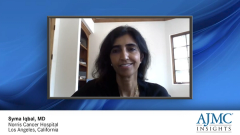
Decision-Making Within a Rapidly Evolving Field Where Labeling May Differ From Current Clinical Guidelines
Laura Bobolts, PharmD, BCOP, and James M. Cleary, MD, provide insights regarding gastroesophageal treatment decisions when FDA labels don’t reflect clinical practice guidelines.
Episodes in this series

Laura Bobolts, PharmD, BCOP: [Sometimes] guidelines may not capture the expanded FDA-approved labeling, meaning a guideline may be more detailed or restrictive in its wording in the appropriate use of a therapy, while the FDA indication may be broad. An example is the FDA indication not requiring PD-L1 positivity and the NCCN [National Comprehensive Cancer Network], which does require PD-L1 positivity. Many may not know this side of the oncology managed care world, but a payer is highly regulated in what’s coverable from an insurance standpoint and what’s a medically accepted use or a medically necessary therapy, meaning a payer is regulated to cover that therapy.
To give a high-level summary of these regulations, for your Medicare members, if the FDA indication is broader than the NCCN, then the broader of the 2 likely justifies insurance coverage in most scenarios. Where you get down to the details is possibly with the commercial insurance in which the payer may have detailed drug coverage policies. In that scenario, a payer could possibly write PD-L1 positivity into their coverage criteria to align with where the therapy may be more efficacious to align with NCCN compendium, even if the FDA indication is broader. But should a payer do that, they may end up covering a therapy that’s different for one patient population compared with another. They may have more detailed coverage criteria for a commercial member than for a Medicare member. In that scenario, a lot of times payers want to align coverage to keep all patients on an equal playing field. Given that scenario, I’ve seen that the majority of the payers align coverage with the broader of the indications, whether it’s the NCCN or FDA indication. But there are a lot of nuances that can work about in between in that setting.
James M. Cleary, MD, PhD: This is a very exciting time to be a clinician, because clinical research is moving so rapidly that we’re always getting newly FDA-approved drugs. Keeping up with the literature is so important, but sometimes the data show that a certain drug works well but isn’t in the guidelines. The challenging thing is that you don’t want to hit your patients with financial toxicity. You don’t want to write for a drug and have insurance not pay for it. Then the patient has to pay for this very expensive drug, which can cost several hundred thousand dollars.
Clinicians have to think about what drugs are out there, including the new ones, and what’s best for your patient. Once you’ve identified what’s best for your patient, if that isn’t approved because it’s so new and not in the guidelines, then you have to look for a way to get the drug paid for. Sometimes the insurance company will pay for it. You can oftentimes appeal to the insurance company. If there are second- or third-line data and phase 2 and phase 3 studies, sometimes you could persuade the insurance company to pay for it. Other times, the insurance company holds firm and says, “It isn’t in the guidelines.” In those cases, we reach out to the manufacturer and ask them if they have a patient-assistance program through which we could get the drug for free from the drug company.
Transcript edited for clarity.
Newsletter
Stay ahead of policy, cost, and value—subscribe to AJMC for expert insights at the intersection of clinical care and health economics.










































